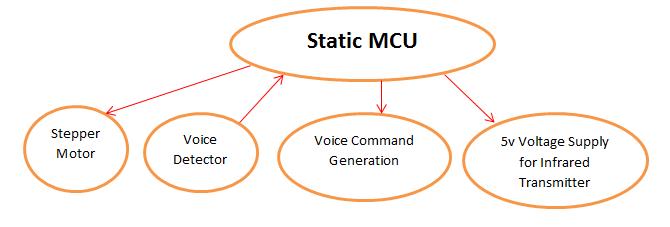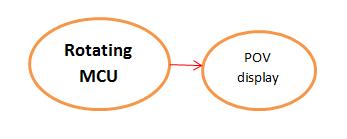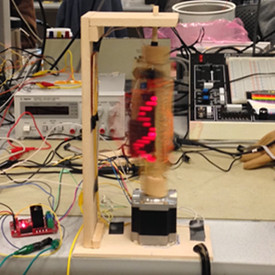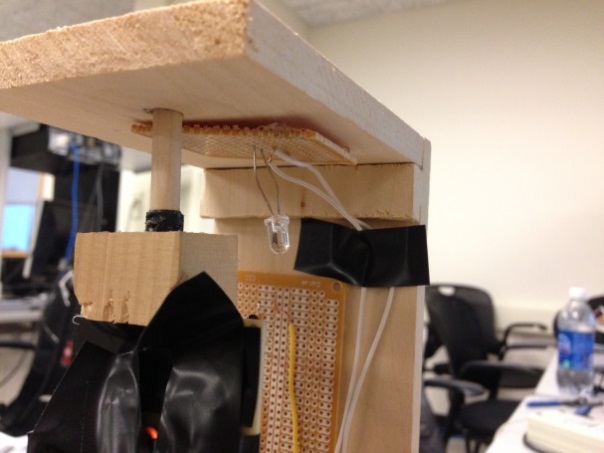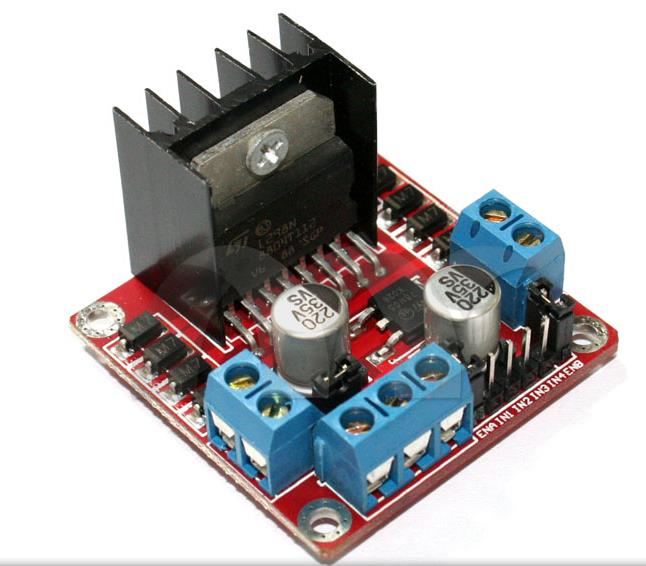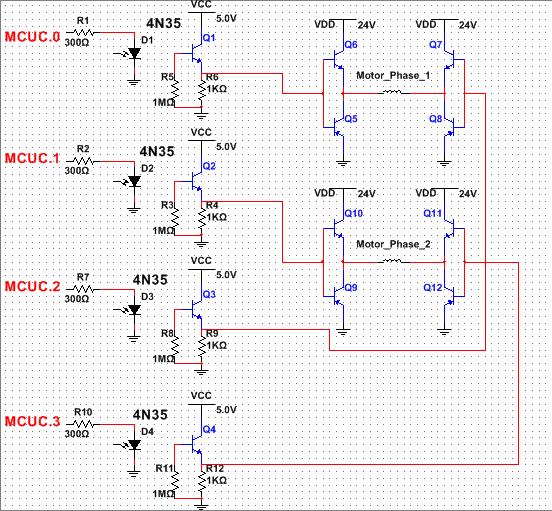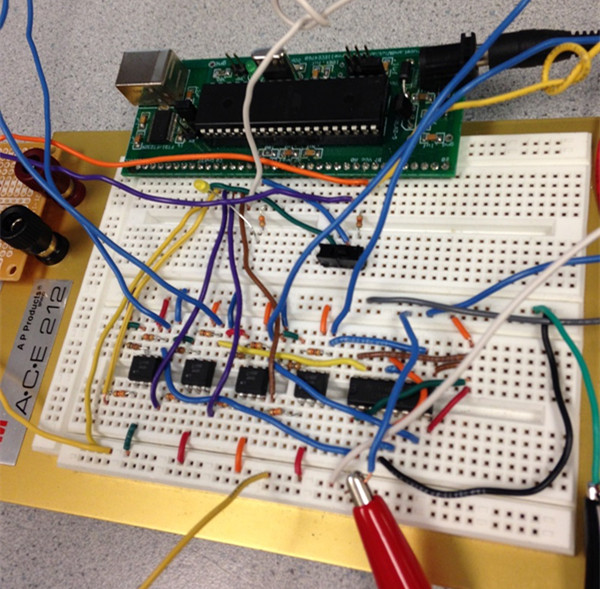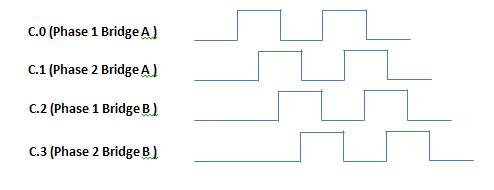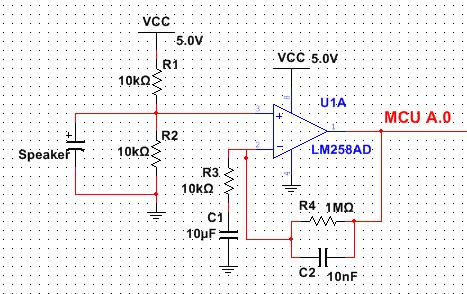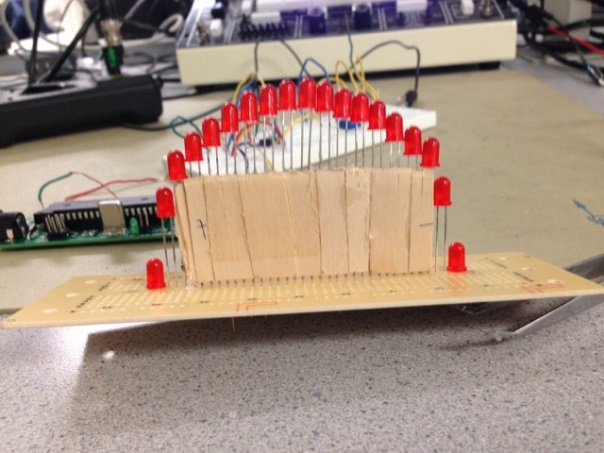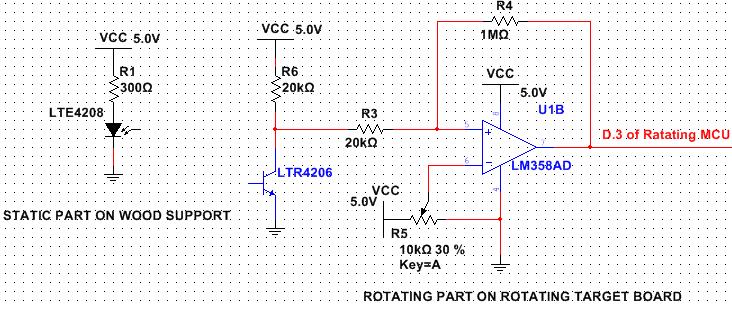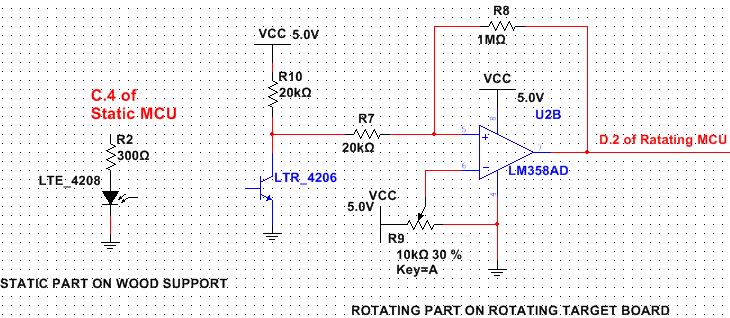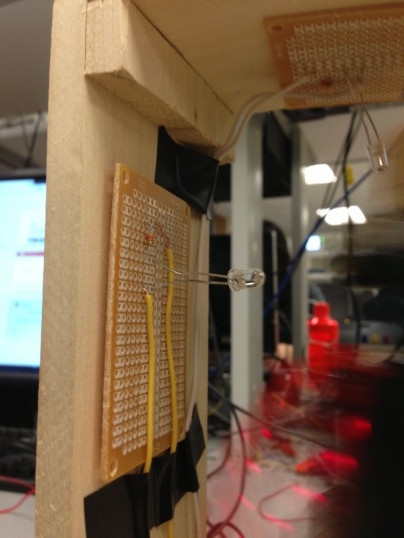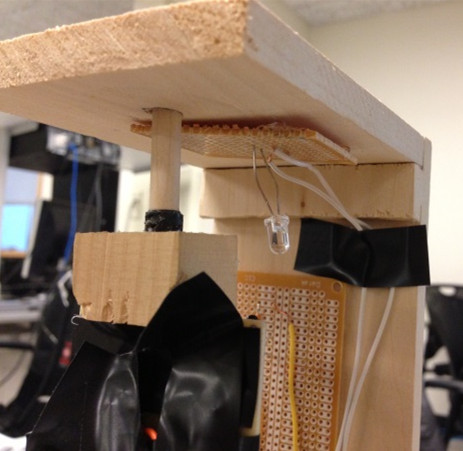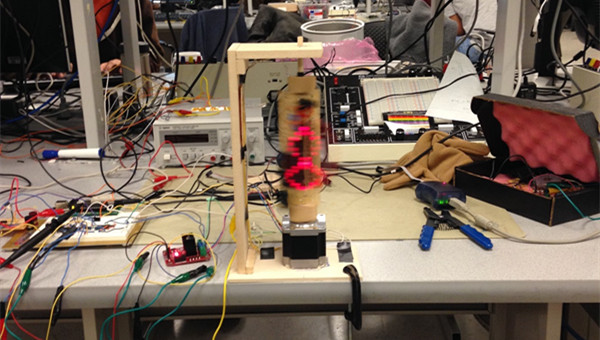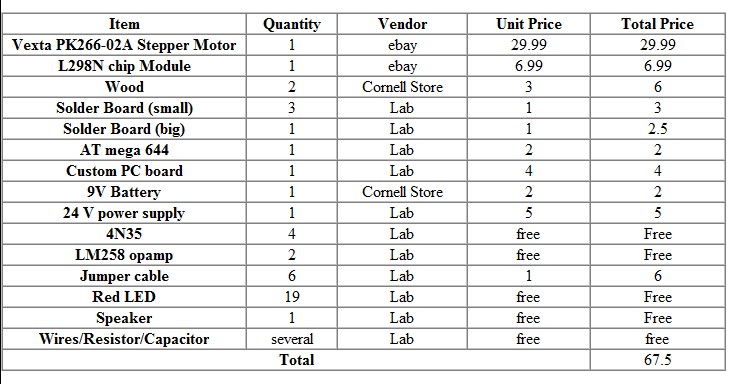1.Introduction top
In our final project of ECE 4760, we designed a magic 8 ball, which is a rotating POV (persistence of vision) display controlled by voice commands. In our design, users can ask yes/no based questions via a small speaker, and the rotating POV part can display random answer of yes or no to answer that the question. The system works just as the traditional magic 8 ball, with the answer displaying on a sphere created by a series of rotating LEDs and using the persistence of vision mechanism.
A persistence of vision (POV) refers to the phenomenon of the human eye in which an afterimage exists for a brief time (10 ms). A POV display exploits this phenomena by spinning a one dimensional row of LED's through a two dimensional space at such a high frequency that a two dimensional display is visible. In our case, we created a sphere display by spinning semi-circle shaped LEDs around a central motor shaft. The rotational speed of the LED’s is fast enough such that the human eye perceives a two dimensional image.
The overall design of this project can be grouped in the following three categories: circuit design, mechanical design, and software design. The most labor intensive portion of this project was the mechanical design and the circuit design. The circuit schematics and software design should be integrated on the frame work of mechanical structure, which is the most challenging part of our design implementation.
2.High Level Design top
The original idea of our project came from a very popular American sitcom in the 90s – Friends. In this show, we saw the magic 8 ball for the very first time, and were amused by Ross asking it whether he should see Rachel again. Being a huge fan of Friends and attracted to the idea of asking questions to a magic ball to make complicated decisions, we decided to build our electrical version of magic 8 ball, with which people ask questions via a small speaker to the ball and get random answer displayed automatically.
The next step of our design was a series of brainstorming to decide how the answer would be displayed. In our first scheme, a plastic ball with a LCD screen embedded in it would be responsible for displaying answers. A stepper motor would drive the plastic ball to spin when people starts to ask questions and stop after people finishing the questions. In other words, our first scheme is about voice commanding the motor spin or stop, while LCD display random answer when motor stops. After a series of further discussion, we quickly drop this scheme because we met several folds of skill limitation. First, it is hard to embed a LCD screen to an integral plastic ball and fix a microcontroller in such as small area. Second, it is also hard to synchronize the motor and the LCD display, which means no good ways to tell the ball when to display random answer if no electric components like a speed sensor or a displacement sensor are employed to the system. To simply our design, we gave up our first design scheme and adopted another display scheme, the POV display.
Using POV display helps us avoid several skill limitation mentioned above. First, we don’t need an entity version of ball to do the display. Instead, we only need a series of semi-circle shaped LEDs rotating in a central shaft to create the outline of the ball. Meanwhile, by lighting certain LEDs, we can create the vision of displaying figures on a spherical surface. Second, we don’t need to employ such speed sensor or displacement sensor as mentioned before, we only need an infrared emitter on the non-rotating frame to send voice commands, and an infrared receiver on the rotating part to receive commands. To fulfill these, we only need a circuit board to serve as the rotating part, on which a series of semi-circle shaped LEDs, speed measurement circuit, voice command receiver, a MCU and a battery are embedded. In order to be able to drive the rotating circuit board, we need a high-torque motor.
The POV display logic behind our project is very straightforward. Our software must calculate the rotations per second (RPS), and set the time duration to display each "pixel" of the display (explained in software section). From a high level design, we simply measure the period of each rotation, divide time the central shaft takes to rotate through that section by the number pixels we allow to display and then calculate the amount of time each pixel occupies during the rotation. By turning on a LED for just that duration of time, we can then display the pixel. There are 19 LEDs consisting of the semi-circle, and we define two degree as a pixel while figures are only allowed to display in 180 degree. Thus, we mapped the entire display area to a 19 by 90 matrix where each element in the matrix represents a pixel.
The nature of our design allows the software and hardware design to be relatively independent of each other in terms of tradeoffs. However, there do exist some cases in which hardware circuit design may affect the stability of our software. For example, we have two infrared receivers on our rotating circuit board: one to measure the speed and synchronize the display, another to receive voice commands to display corresponding figures on the spinning spherical surface. It is important that these two infrared emitter commands from non-rotating frame should only give commands to its corresponding receiver.
The system schematic diagram is shown in Figure 1. As we can see from the diagram, two MCU has different responsibilities and cooperate together to fulfill the entire function as a rotating POV display.
3. Design top
3.1 Mechanical Design
Because we expect to rotate a serial of LED and display figures in spherical surface, we need to fix both side of the board containing the serial of LED (in case it shaking too heavily and affecting the receiving of infrared signal). Besides, we need to fix two IR transmitters, making the IR receivers on the rotating board receive a signal per revolution. So we build a wood support for our POV, both used to fixed the free end of the rotating board and to fix the IR transmitters. The picture of our support is shown in Figure 2. The shaft we used to connect the upper end of the rotating target board is shown in Figure 3.
We make two small pieces of woods with hole in it, and paste these two pieces of woods to both ends of the board containing the LED. One was connecting to the stepper motor, and the other was connecting to a shaft which going through a hole in the top board. One thing we need to make sure is that the shaft of the motor should be in the exactly same position with the top hole of the board and the shaft in the top. After doing these, we can guarantee the serial of LED can rotate smoothly and receive the signal from infrared.
3.2 Hardware Design
3.2.1 Motor
In our design, a motor is needed to drive the rotating part to spin at around 10 RPS to achieve the best performance of POV display. Because our rotating circuit board has a lot of electrical components embedded on, we need a motor which can generate high torque. Besides, we also need our motor to run at a constant speed, and if the load changes in a variable range, the motor should still hold the constant speed. In our design, we can choose between three types of motors: DC motor, AC motor, and a stepper motor.
Because of the current/torque relationship:
we cannot achieve very big speed changes due to torque limitation. In other words, in order to meet the criteria of torque generation to drive the rotating part, we have to slowly ramp up the motor speed. For an AC motor, we have to use a voltage adaptor to ramp up the input voltage, which means more hardware implemented. As for a DC motor, instead of using PID control, we can simply apply a constant DC voltage to achieve constant motor speed in condition of motor load not changing in a wide range. As usual, we also have to slowly ramp up the input DC voltage to meet the torque limitation. Both of the AC and DC motors require additional hardware (such as voltage adaptor or regulator) to achieve input voltage ramp up in order to slowly regulate the motor speed to rated value. So, we chose a stepper motor, which makes us able to ramp up speed only using software.
Stepper Motor Hardware Implementation
We chose Vexta PK266-02A stepper motor because it can generate the holding torque of up to 166 oz-in. Considering that our rotating part is quite heavy and torque consuming, we also need to use this stepper motor in bipolar mode, in which the coil is twice as the unipolar. And we also adopted 50% control signals overlap to maximum the torque output. When used in bipolar mode, the coil resistance for one phase is 4 ohms, and because the rated current for one phase is 2A, so we need at least 8V voltage input. With the speed of the motor increasing, the coil impedance also increases. So, we need more than 8V voltage input. After several trials, we found out that a 24 volts output voltage with 2A rated current power supply can drive our stepper motor to rotate at around 10 RPS.
Another important issue about the hardware circuit implementation is about control circuit, drive circuit, and the isolation between them. Because we use the motor in bipolar mode, we need two H bridges for both phases of the coil. We chose L298N model (shown in Figure 4) as the H bridge drive-circuit in consideration that it can handle up to 2A emitter/collector current when switched on. And it can handle up to 36V collector-emitter voltage when switched off, which means it can be used in our 24 volts power supply. Note that the L298N model we bought has already had four freewheeling diodes connected in antiparallel with each phase of the inductive load, so we can safely use this model to drive a stepper motor and do not need to worry about no current return path for the motor coil when the H-bridge is switched off.
We used MCU C.0~C.3 port to output sequential control signals for two phase of our stepper motor. It is important to isolate this control circuit with the drive circuit of H bridge, because the drive circuit may draw up to 2A current and if this high current couple to MCU control circuit from common ground resistor, MCU pins may be destroyed. In our design, we use 4N35 to isolate the control and drive circuit. Note that 4N35 has the bandwidth limitation of 1K Hz, so the stepper motor has the speed limitation coming from the restriction of control signal frequency. The schematic diagram of our electric circuit design is shown in Figure 5. And the module diagram of control circuit is shown in Figure 6.
Stepper Motor Software Implementation Overall
We need to generate four sequential control pulses to apply on the four gates of the two H bridges, sequentially switching them on and off. Each pulse is a step for the stepper motor. So for Vexta PK266-02A stepper motor, which needs 200 step per revolution, we need to generate pulses of 500Hz in order to make the stepper motor rotate at the speed of 10 RPS. The pulse sequence is shown in Figure 7.
Note that we overlap the pulse signals by 50% to achieve the best bipolar torque performance.
As discussed in the previous part, we can ramp up the motor speed using only software. To be specific, we first start the pulse rate at a very low frequency, and slowly ramp up the pulse rate to 500 Hz. The stepper motor can then be driven smoothly.
3.2.2 Voice Detection
Our design should be able to recognize the existence of voice. We do not need to detect the content of the speech, for that’s a lot of software work and can be very complicated due to algorithm complexity and unable to resolve by the MCU. Instead, we only needed to distinguish between people speaking and silence. We implemented our software to have a quite good noise tolerance threshold, which means it can only regard it as valid speech input only in condition that people talk to the microphone very close.
Otherwise, the voice detector will regard any other conditions as no voice input.
Audio Circuit Amplifier and Filter
The amplify circuit is shown in Figure 8. In our design, we use a speaker to detect air vibrations. The microphone used in this project uses a charged capacitor to detect vibrations in the air, and convert the vibration signal to electrical signals. R2 and R3 provide a 2.5V DC voltage bias for the output to allow the large waveform amplitude and convert the original negative part of the waveform to positive. We used LM358 to work as both voltage amplifier and band pass filter. We need a band pass filter because we only need the fundamental component of human voice, which is below 300 Hz. The output voltage of microphone is amplified by 100 times using LM358 negative feedback. The output of the amplifier will be fed to ADC converter of MCU and being analyzed.
3.2.3 Rotating POV circuit
We use a circuit board as a frame of our rotating POV circuit. A series of LEDs in semi-circle shape, and two infrared receivers with corresponding Schmitt Trigger should be soldered on that target board. Besides, the rotating board should also include a MCU, and a battery as power supply.
We used 19 LEDs in our design. Because of the constraining of the Atmega1284 current, which should be less than 100mA in total, we connected each LED with a 1K ohm resister to 19 different pin of the microcontroller (All A ports and C ports, and B.0~B.2). Because we expect the rotation of our LED looks like a sphere, we arrange the LED to be a semi-circle. This means that the length of each LED should not be the same. Figure 9 shows the LED array implementation.
We made it by firstly draw a circle, and then separate it to 19 parts, calculating the length of each parts, thus the length of each LED. Both ends of the LED are pretty easy to make. We simply cut the LED to be the fit length. But when it comes to the middle, we solder the LED which are not long enough to wires and then to the board. We also paste these LED to a piece of wood for supporting.
We use two sets of infrared transmitter & receiver in our design. For both of them, transmitters were fixed on the wood support, and the receivers were soldered on target circuit board, rotating with LED display. One of the infrared transmitter & receiver set is used to synchronize the motor speed and the rotating display position. Another infrared transmitter & receiver set is used to give voice command to rotating circuit board. The schematic diagram of infrared transmitter & receiver set we used is shown in Figure 10. In the diagram, the LTE4208 was fixed in the wood support, while the LER4206 and corresponding peripheral circuit was soldered on rotating circuit board. We use one LM358, connecting one receiver to the port 3, and another receiver to port 5. Then, the output ports 1 and 7 are connected to port D2 and D3, which are both external interrupt input of the microcontroller, respectively.
3.3 Software Design
In our design, we use two MCU: one of them is static (referred as static MCU below), and another one is rotating with the rotating circuit board (referred as rotating MCU below). The static MCU is used to generate sequential pulses to control the stepper motor, processing voice detector’s output signal using AD converter, generate voice command signal, and supply 5V voltage to the speed synchronization infrared transmitter. The rotating MCU is used to control the POV display. These two parts of MCU program are quite independent.
Static MCU Program
The static MCU is responsible for controlling the stepper motor and do AD conversion to process the analog signal of microphone circuit and generate corresponding control signal (C.4 as shown in Figure 10.B) as voice commands. The static MCU should also supply power for the infrared transmitter which is used to synchronize the motor speed and the position of the POV display.
In our program, we use C.0 ~ C.3 to generate four sequential pulses to control the stepper motor. We use Timer 0 compare match interrupt to generate a time-base, and generate pulses in width of 86 time-base long. Note that we need to ramp up the motor speed very slowly in order to meet the torque limitation, so we firstly set every pulse width to be 200 time-base long. Then, we gradually reduce the pulse width until the desired speed. All the pulse generation and ramping are done in TIMER 0 COMPA interrupt.
We also use C.4 port as voice commands, supplying output voltage to one of the infrared transmitter. We define C.4 output logic 1 as no valid voice detected and define C.4 output logic 0 as valid voice detected. And the C.4 output should also remain 0 if people aren’t finishing their speaking but pause a little bit in the middle. In another word, our software should process the analog voltage output of the microphone circuit, generating corresponding binary voice command (0 as voice, 1 as no voice) and be applied to one of the infrared transmitter. The software should be able to have a noise tolerant threshold, which means it can only detect people speak to the microphone very close as valid voice input and regard other situation as environment noise. Besides, the software should also distinguish between pause of the speech and the actual finishing of the speech.
We use AD converter channel 0 (A.0 pin) to convert analog voltage between 0 and 5 V to corresponding 8 bits integer. We set around 1.5 seconds of time to detect the biggest and smallest integer and do reduction. If the difference is bigger than 80, we recognize that we have a valid voice input, otherwise, we regard it as no valid voice input. By adopting this method, we can achieve both noise tolerance feather and distinguishing between pause and actual finish of a speech.
Rotating MCU Program
We achieve POV by rotating a serial of LEDs, turning on and off these LED in different positions. If the rotation speed is fast enough, these LED will look no longer a serial of LEDs, instead being a sphere. So if we want it to display image with these LEDs, we only need to decide in which position of the rotating do we need to turn on the corresponding LEDs.
In the initial part of our code, we initialize the interrupt for timer0 and timer1, the ports for LED, and initialize there array for displaying ‘8’, ‘yes’ and ‘no’. Each of the elements in these arrays is a 19-bit binary number, with each bit representing one LED. And the size of these arrays varies according to how many degrees do we want to display figures.
In main function, we first execute the initial function, and then stay in while(1) loop waiting for interrupts.
We combine TIMER2_OVFL_vect interrupt and INT1_vect interrupt to calculate the time for every revolution. In INT1_vect interrupt, we receive the signal of measuring the rotation speed and calculating the time it needs per cycle, then divide it to 180, the result being the time it needs per 2 degrees. Then we set OCROA to match the time for 2 degrees and set ‘ledPos’ to 0 which will be used in the next interrupt. In this interrupt, we should also read the corresponding port for voice commands input and decide whether to display the figure ‘8’ or the random answer of ‘yes’ or ‘no’. We use random number generation function rand() to generate a random number, and display ‘yes’ if it is an even number while display ‘no’ if it is an odd number.
In TIMER0_COMPA_vect interrupt, we add 1 to ‘ledPos’ every time entering this interrupt. Because we want to display the image in the middle, we need to carefully deal with the start position. With many practice, we find that we should ‘cut’ the first 60 degrees. Thus, we need to not turn on the LEDs until ‘ledPos’ larger than 30. Because we use the ‘ledPos’ as the index of the element of the array displaying images mentioned before, consequently, we need to decrease the index by 30. And we assign the 19bit of the element of the array to PORTA, PORTB, and PORTC. After all the images are displayed, we need to set PORTA, PORTB and PORTC to 0 again, which turn off these LEDs.
4. Testing
We mainly adopted incremental design methodology in our final project. Because our project can be divided into two independent parts: the static part and rotating part, we can implemented them separately and after verifying that each part is functionally correct, we can then assemble them together and make them work as an entirety.
Testing for Static Part
We first wrote the code to drive the motor. In this period, we realized that we need a 24V power supply to drive the motor and guarantee the 2A rated current in order to generate enough holding torque. Besides, we also found out that the ramping parameter should be deliberately set and tested to make the motor start to spin smoothly. After we successfully run the motor, we tested its holding torque. It turned out that it can drive our target board at around 10 RPS and that’s still beyond its torque limitation, so when loaded, the motor kept running very smooth, without any situation of escaping phases or rough vibration happening.
Secondly, we tested the voice detector circuit. It turned out that the amplifier works well and can output voltage between 0 and 5V in correspond with voice magnitude. Then, we fed the output of the amplifier to MCU pin A.0, which is the ADC input channel one, and tested our code for binary voice commands generation. It took us several trials to decide the appropriate noise & valid voice input threshold as well as the number of sampling in one comparing cycle. By using oscilloscope, we finally verified that our voice detector circuit cooperate our ADC processing code can generate good noise tolerant binary voice commands with good distinguish between pulse and finish of a speech.
Testing for Rotating Part
We first tested our on-board schmitt triggers to guarantee no false edge trigger. Then we tested our wire connection of the LED array and wrote code to make sure every LED can be lit and turned off correctly. Another important issue we should test is the sequence of the two infrared receivers capturing corresponding transmitter signals. Basically, because we read the voice command value in speed measurement interrupt (INT 1), we need to guarantee that the rotating part has already received voice commands when speed measurement interrupt being triggered. After these basic verifications, we started to test our POV display code.
First of all, we wrote basic POV code, letting the rotating LED array only display the figure ‘8’. This means we don’t need to include any voice commands both in hardware and in software. Second, we added voice commands to our design and debugged for proper response with different voice input. One important issue in debugging is that we should avoid the interference of two infrared transmitter & receiver set. In other words, we should make sure the IR receiver used for speed & position synchronization can only receive commanding signals from its own IR transmitter. Basically, what we have done to guarantee this signal separation is simply use black plastic to block IR receiver from one of the IR transmitter.
For our final project, the software is quite straightforward and simple. The most testing job we did is about hardware verification and hardware & software collaboration. Meanwhile, it should also be taken into consideration that the mechanical structure of our design should guarantee the stability of software & hardware. For example, we firstly did not fix the upper end of the rotating target board to the wood support and made it a free end while rotating. However, in our software debugging, we found out that when the stepper motor started to run at a high speed (8 RPS or higher), the unfixed free end started to sway in a wide range, causing the IR receiver cannot receive control signals from corresponding IR transmitter. So, we altered in our mechanical structure, fixing the free end of the rotating board using a shaft and connecting it to the wood support through a hole.
5. Result & Conclusion top
Our final project uses POV to display figures on a spherical surface. It can fulfill the function of a simple version magic 8 ball. When people start to ask it questions, it display an ‘8’, and when the microphone detected the end of the question, our device will display a random answer of ‘yes’ or ‘no’. Our device can run very stable, the POV synchronization is good, so the figures we display can keep steady and the edges of the figure never move. Another feature about our device is that the LED array can generate quite bright light, people can see the display without having to turn off the light.
The display result of our device is shown in Figure 11.
6.Appendices top
A. Program Listing
- POV_code.c (11 KB)
- MotorVoice_code.h (4 KB)


